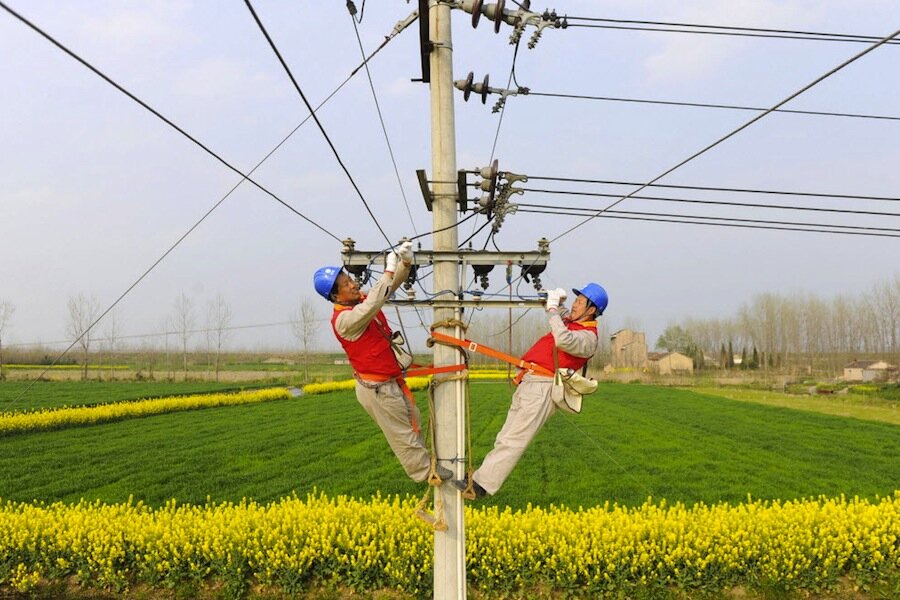Electricity data: Chinese growth is slower than advertised
Loading...
Last year China reported the slowest economic growth in 24 years, about 7.4 percent. But the true figure may actually be much lower, and the evidence is buried in electricity figures, which show just 3.8 percent growth in electricity consumption.
David Fridley, a staff scientist in the China Energy Group at the Lawrence Berkeley National Laboratory, has been a longtime collaborator with the Chinese on energy management, efficiency, and policy. Fridley, who has held Chinese energy-related jobs for 35 years, believes that electricity consumption in China is a better indicator of its economic growth.
Historically, electricity consumption and economic growth in China have been very closely linked. "From 2005 to 2013, the average elasticity of electricity demand was 1.09, meaning electricity demand was up about 1.09 percent for every percent rise in GDP," Fridley wrote in an email. "In 2014, that number fell to 0.51, the lowest in this 10-year period. During the economic crisis of 2008, it did fall below the average, to 0.60, but quickly rebounded to above 1."
That tells Fridley that something is up. He's not the only one who thinks the government growth numbers aren't reliable. China's premier, Li Keqiang, has said China's GDP figures are "for reference only." Bloomberg reported that in a declassified US diplomatic cable from 2007 then-US ambassador Clark Randt related a dinner conversation with Li, secretary general of Liaoning Province at the time, in which Li revealed his preferred indicators of Chinese economic activity: rail cargo volume, loan disbursements and – wait for it – electricity consumption. China's leaders don't believe their own government growth numbers.
Fridley notes that electricity consumption figures are considered quite reliable and have suffered only minor revisions over the years. Preliminary numbers for the first quarter of 2015 suggest further slowing of the economy as year-over-year electricity consumption growth decelerated to just 0.8 percent. February data showed a 6.3 percent decline in electricity consumption from the previous month. March saw another decline of 2.2 percent.
Fridley also notes that residential electricity growth registered an extraordinary fall: "From 1980 to 2013, residential electricity grew on average 13.5 percent a year – and last year it fell to 2.2 percent. From 2005 to 2013, elasticity of residential energy demand was 1.11, and fell to 0.30 in 2014. This is unprecedented."
But it wasn't just electricity consumption that seemed out of step with China's reported growth rate. Fridley wrote that diesel and natural gas demand also indicated slowing economic growth:
Diesel demand in 2014 fell slightly, also for the first time, and the growth rate for natural gas was the first time it had been below double digits this century. Diesel demand growth is primarily driven by trucks hauling freight, and although the 2014 numbers for freight by mode aren’t out yet, the 2013 freight numbers went flat after growing by 3 to 4 billion tonnes per year since 2000. Trucking freight actually fell by over a billion tonnes. Rail freight was flat.
Does all of this prove that China's reported economic growth rate was inflated in 2014? Fridley again:
At this point, the data point to an economy that is weaker than what official GDP would say, but there’s not enough complete data available for 2014 to really understand everything that is going on. Others do provide their speculations, and perhaps some of it is spot on, but I just follow the data.
Economist Michael Pettis has been forecasting much lower growth in China for the rest of this decade as China re-balances its economy away from high investment and toward consumption. He says this has happened to every high-growth economy in the past and will almost surely happen to China.
He explains that it will come in one of two ways:
In the best-case orderly adjustment, growth rates will drop every year, more or less smoothly, as credit growth is constrained and investment growth drops with it. As the reforms proposed during the Third Plenum are implemented, ordinary Chinese households will benefit from direct or indirect transfers from the state sector, so that total household wealth will continue to rise more or less in line with the growth in household income during the past decade. In that case, consumption growth will remain in the 5 to 8 percent range.
The second way will not be so pleasant:
A disorderly adjustment will have a different dynamic. It is likely to occur after another two to three years of relatively high (7 to 8 percent) GDP growth rates followed by a very ugly contraction once debt capacity is exhausted – which will occur when new loans cannot grow fast enough both to roll over existing bad loans (by which I mean loans that funded projects whose returns were insufficient to liquidate the loans) and to generate economic activity. Average growth rates in the case of a disorderly adjustment will be well under 3 to 4 percent but the adjustment will be highly discontinuous.
You might have to read Pettis's words twice to get the full import of them. But he's explaining why China will grow more slowly in the future one way or another.
So, the question is: Has China entered this slow-growth phase which Pettis believes it must? Or will the adjustment to slower growth be delayed once again? No one knows for sure. But energy consumption statistics hint that China may have already begun its descent into slower growth and that that growth will be much slower than almost anyone except Pettis has forecast.







